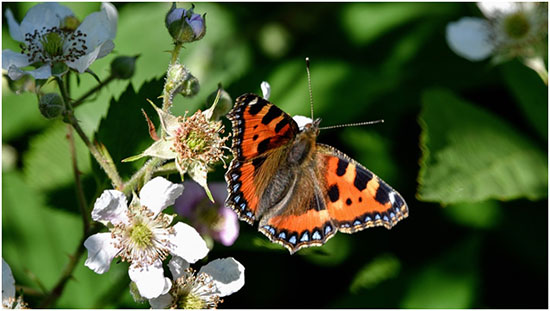How To Grow A Butterfly Garden

How to Grow your own Butterfly Garden
I don't think there's a person alive who can't appreciate a garden full of lively butterflies. There's nothing quite like enjoying a summer day while watching butterflies lazily fly around your garden. Sadly, many butterflies have lost their natural habitats due to urbanisation and other human-related activities.
Thankfully, all isn't quite lost. You can provide a home for a host of butterflies by starting your own butterfly garden! Not only will this be a fun activity to do during your free time, but it'll make your garden the envy of the neighbourhood!
With that being said let's jump into how to start your own butterfly garden.
Step by step guide on how to start your own butterfly garden
Step 1: Do your research
To begin, research the types of butterflies native to your area. This is important because it will directly affect the types of nectar and host plants you'll need to set up in your garden. One way you can go about doing this is by conducting online research or by looking at a guide on butterfly species. You can also pick a day to simply walk around and visually observe the butterflies flying around your neighbourhood.

Step 2: Plan your garden
After conducting thorough research, you'll want to plan the layout of your garden. Planting your flowers together in groups, for example, will allow butterflies to flit from plant to plant more easily. With that being said, planting your flowers in a wider radius will allow you to observe and enjoy butterfly behaviour a bit more thoroughly.
As you analyse the layout of your garden, consider the size of your plants once they have fully matured. You should also group them by colour and bloom time. Shorter plants should be close to the front and taller plants near the rear. Also, consider planting your garden where you can easily view it from your home. That way you can enjoy your beautiful butterfly garden both indoors and outdoors.
Step 3: Plant with the sun shining overhead
One thing that butterflies have in common with plants is that they both need at least 6 hours of sunlight every day. This is especially true of plants that produce nectar which should be in the optimal place where they can bathe in the sunlight from mid-morning until mid-afternoon. Butterflies are only able to fly due to the warmth of the sun and often only feed in the sunlight. It's imperative that you place your plants in a protected place that gets plenty of sunlight.
Step 4: Plant flowers that produce nectar
There's really only way to attract butterflies to your garden -- by planting flowers that produce pollen and nectar of course! Butterflies are capable of detecting edible nectar through the receptors in their feet, antennae, and legs. Butterflies also detect their favourite food by detecting certain types of colours.
If you know what type of butterfly is native to your area, you can plant the flower that will most likely attract them. However, you should also plant a wide variety of nectar-producing plants to attract the greatest variety of butterflies.
As you plant, go for large groupings of flowers rather than planting individual flowers. Doing so will greatly increase the chances of attracting more butterflies.
Step 5: Provide a place for butterflies to lay their eggs
Your garden shouldn't just have nectar-producing flowers. It should also have herbs and vegetable plants which will provide a place for butterflies to lay their eggs. The best plants include:
- Carrots
- Chives
- Dill
- Sage
- Parsley
Butterflies are attracted to certain types of plants and vegetables because they're looking for an adequate source of food for their larvae when they're born.
Step 6: Go the organic route
Butterfly gardens are typically created to beautify your yard and to provide a home for the local butterfly population. You can continue providing a benefit to mother nature by using organic means to rid your garden of pests. Keep away from insecticides and pesticides. Doing so will provide a safe place for your butterflies to thrive.
Attracting butterflies to your garden
Create a "puddling" area
Butterflies tend to gather in areas where there is puddling to absorb the minerals they need. You can make a puddling area easily by digging a shallow hole in your garden and placing a piece of plastic along the bottom. Then fill it with wet dirt, and you'll be done.
Provide plenty of water
Tree sap, nectar, and dew are all adequate sources of water for butterflies. Moist dirt and puddles are also great places where they can gather and drink water.
Plant for continuous bloom throughout the year
Every season brings with it a new cycle. For example, butterflies come out of hibernation during spring and require blooming flowers to be nearby so they can feed immediately. Butterflies also need flowers to bloom during autumn to help them build the reserves they need to survive the coming winter. Try to plant a wide variety of flowers so that you have plants blooming during all seasons.
Provide caterpillar friendly food
Believe it or not, caterpillars are concerned about their dietary requirements. That's why they would starve rather than eat the wrong type of plant. Female butterflies are always on the lookout for food that caterpillars prefer to eat. If there is no food available, the butterfly may choose another location (other than your garden) to lay its eggs.
Place flat stones throughout your garden
After fluttering around to and fro all day butterflies are going to need a flat, solid surface to rest and spread their wings to soak up the sun. Doing so allows them to essentially recharge their battery to allow them to continue flying and feeding. Often butterflies rest on vegetation, stones, and bare soil. Placing a few flat stones throughout your garden will provide perches for butterflies to set down and recharge.
Add plenty of colour
As mentioned before, butterflies can do more than just detect food from smell alone. They can also detect food bycolour. Planting flowers that are purple, yellow, and red will likely be the best options to attract butterflies to your garden.
Provide food for adult butterflies
Often brightly coloured plants are the food of choice for adult butterflies. Adult butterflies also tend to prefer large clusters of tubular flowers. It's always a good idea to plant your flowers in groupings to increase your chances of attracting more butterflies.
Choosing the right plants to attract butterflies
If you're going to attract butterflies to your garden you'll need to plant the right type of flowers and vegetables. You'll want to start with plants that produce nectar. These include:
- Asters
- Purple coneflowers
- Butterfly weed
You should also look into host plants for caterpillars such as:
- Nettle
- Willow
- Violets
If you arrange your garden with the right types of plants, you'll make it irresistible for the local butterfly population. If you're looking for a more colourful assortment of butterflies to visit your garden try planting oregano, butterfly bush, marigolds, and milkweed.
An extra treat for your winged visitors
Besides nectar and pollen, butterflies can't get enough of the sugar produced by rotting and overripe fruit. Therefore if you have a fruit tree in your backyard try placing a few pieces of rotting fruit in your garden. Don't be surprised if you find your garden swarming with butterflies the next time you come outside!
Enjoy your butterfly garden!
Don't worry about growing a large garden if you're limited on space.Butterflies are known for visiting gardens of all sizes so even a small garden with a few plants will be more than sufficient to create a thriving ecosystem.
Once you've followed the proper steps and have your butterfly garden in place, you should soon find your yard filled with butterflies. The final step is to sit back and enjoy the fruits of your labour!
Featured Image Credit: dpexcel / Pixabay
In Post Image Credit:coyot/ Pixabay
How To Grow A Butterfly Garden
Source: https://billyoh.com/resource/grow-butterfly-garden
Posted by: hookcounces.blogspot.com

0 Response to "How To Grow A Butterfly Garden"
Post a Comment